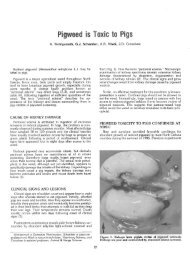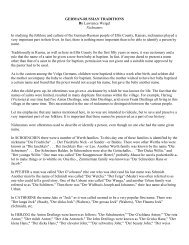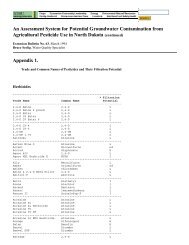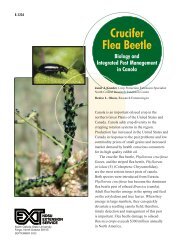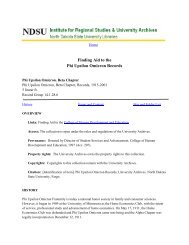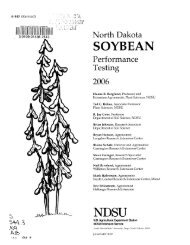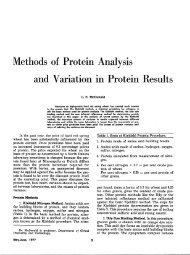germans from russia in fort collins, 1900-2000 - Libraries
germans from russia in fort collins, 1900-2000 - Libraries
germans from russia in fort collins, 1900-2000 - Libraries
You also want an ePaper? Increase the reach of your titles
YUMPU automatically turns print PDFs into web optimized ePapers that Google loves.
WORK RENDERS LIFE SWEET: GERMANS FROM RUSSIA IN FORT COLLINS<br />
American-born generation of Germans <strong>from</strong><br />
Russia realized that English-language education<br />
was a spr<strong>in</strong>gboard out of the gruel<strong>in</strong>g<br />
cycle of beet-field labor. But attendance did<br />
not improve. A 1923 report <strong>from</strong> the U.S.<br />
Department of Labor found that truancy and<br />
status <strong>in</strong> Larimer and Weld county schools<br />
were directly related. The children of beet<br />
farm owners attended 90 percent of school<br />
days each year; those who rented sent their<br />
children almost 89 percent of the time; but<br />
children of contract laborers missed a quarter<br />
of the school year. Records <strong>from</strong> Larimer<br />
County school districts reveal that the children<br />
of beet workers were absent almost five<br />
times as often as children who did not help <strong>in</strong><br />
beet cultivation. The problem was so rampant<br />
<strong>in</strong> Larimer County that many schools offered<br />
summer programs for the children of beet<br />
workers <strong>in</strong> addition to beet “vacations” dur<strong>in</strong>g<br />
the regular school year. 94<br />
As with child labor, those American<br />
reformers who worried about German-<br />
Russian truancy often misunderstood economic<br />
realities. “I th<strong>in</strong>k lots of Russian-<br />
German children are work<strong>in</strong>g too hard; but as<br />
th<strong>in</strong>gs are, I don’t see any other way out of<br />
it,” a W<strong>in</strong>dsor Hausvater told reporters <strong>from</strong><br />
the National Child Labor Committee. “I want<br />
my children to have the education they need<br />
<strong>in</strong>stead of work<strong>in</strong>g so hard.” 95 But as families<br />
<strong>in</strong>creased <strong>in</strong> affluence, education became<br />
more atta<strong>in</strong>able. In Second Hoe<strong>in</strong>g, as the<br />
Schreissmiller family becomes more successful,<br />
children attend more and more years of<br />
school. The level of highest education – elementary,<br />
secondary, and college – corresponded<br />
to laborer, tenant, and owner.<br />
Beyond the schools, Fort Coll<strong>in</strong>s was the<br />
center of the most tangible symbol of the<br />
Americanization of Germans <strong>from</strong> Russia.<br />
Between 1907 and 1957, <strong>in</strong> the process of<br />
acquir<strong>in</strong>g American citizenship, 1,536<br />
Germans <strong>from</strong> Russia came to the Larimer<br />
County Courthouse to renounce their allegiance<br />
to the Russian (later Soviet) government<br />
and prove their commitment to and<br />
knowledge of the government and history of<br />
the United States of America. Urged on by<br />
the second and third generations of German-<br />
Russian families, who were U.S. citizens by<br />
birth, these older members of the community<br />
had often neglected to naturalize earlier<br />
because they were so engaged <strong>in</strong> their work.<br />
Not surpris<strong>in</strong>gly, the number of petitions for<br />
naturalization boomed <strong>in</strong> the 1930’s as arguments<br />
<strong>from</strong> the younger, more “American”<br />
generation became <strong>in</strong>creas<strong>in</strong>gly persuasive<br />
and forceful. And, as Rock argues, the<br />
younger members of the community felt that<br />
their fathers and mothers had labored hard<br />
enough to deserve the privileges of citizenship,<br />
particularly Social Security. 96<br />
Unlike the First World War, World War II<br />
<strong>in</strong>cited far less ethnic discrim<strong>in</strong>ation. In many<br />
ways, the conflict served to further acculturate<br />
the once isolated German-Russian community;<br />
hundreds of Colorado’s Germans<br />
<strong>from</strong> Russia jo<strong>in</strong>ed the armed forces. Postwar<br />
prosperity, and the liberal education and<br />
home-ownership policies of the G.I. Bill of<br />
Rights expanded the horizons of education<br />
for young German-Russians, mak<strong>in</strong>g it possible<br />
for them to enter professional careers far<br />
<strong>from</strong> the beet fields and allow<strong>in</strong>g them to purchase<br />
homes <strong>in</strong> new suburban developments.<br />
Even the bond that connected Germans <strong>from</strong><br />
Russia <strong>in</strong> Fort Coll<strong>in</strong>s to the sugar <strong>in</strong>dustry<br />
dissolved. German-Russian families left contract<br />
labor positions <strong>in</strong> the beet fields at the<br />
same time America tightened its immigration<br />
policies. Great Western was forced to look<br />
elsewhere for field labor, recruit<strong>in</strong>g Hispanic<br />
families <strong>from</strong> the American southwest and<br />
Mexico. Soon Hispanic families moved <strong>in</strong>to<br />
Buck<strong>in</strong>gham and Andersonville, and the com-<br />
SWCA Environmental Consultants Page 27



